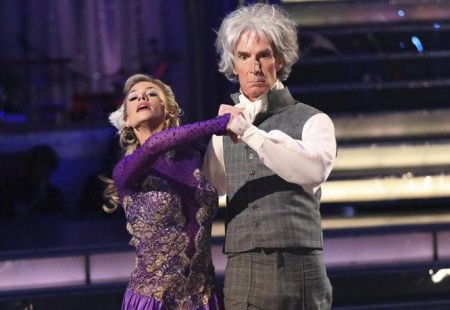Bill Nye’s Painful Anatomy Lesson

Bill Nye, the beloved “Science Guy,” has a lot of fans!
The video of his Week 1 dance on Dancing with the Stars got over 3 million hits! And his fans were able to give him enough votes to allow him to survive elimination, despite being dead last on the leaderboard.
But the 57-year-old Nye got a rather painful anatomy lesson when he tripped while performing the paso doble with partner Tyne Stecklein. Although viewers saw Nye trip near the end of the routine, he did not let on that he had injured his left knee.
A visit to the doctor confirmed that when Bill “stepped on the pant leg of [his] fancy slacks,” he partially tore his quadriceps tendon, perhaps as much as 80%, based on this series of tweets:
Dance pro Stecklein says “The doctor told us, ‘No more. You’re done,’” but Nye still wants to perform if he is able. He’s walking with a brace and cane right now.
Speedy recovery Bill!
Quadriceps tendon ruptures
The knee is essentially a modified hinge joint located where the end of the thigh bone (femur) meets the top of the shin bone(tibia). The patella (kneecap) rides over the joint and is attached by the patella tendon below the knee, and the quadriceps tendon above it.
The four muscles on the front of the thigh (called the quadriceps muscles) work to straighten the knee from a bent position. The quadriceps tendon connects the quadriceps muscle to the patella and provides the power to straighten the knee.
Quadriceps tendon ruptures (tear) most commonly occurs in patients > 40 years of age. It is much more common in males than females(up to 8:1) and occurs in the nondominant limb more than twice as often.
A quadriceps tendon tear can be partial or complete, depending on the extent of the injury.
With a complete rupture the tendon is no longer attached to the patella. Patients complain of acute pain and are unable to extend the affected knee. A physician may be able to feel a separation in the quadriceps tendon.
Those with a partial quadriceps tendon tear usually report an acute onset of pain during sports or a fall. This injury may be associated with a swollen knee with blood in the joint. Unlike complete quadriceps tendon ruptures, these patients may be able to actively extend their knee against gravity.
Incomplete tears and tendinosis (jumper’s knee) can be managed nonoperatively, but complete quadriceps tendon ruptures require surgical repair for optimal outcomes.





























0 comments